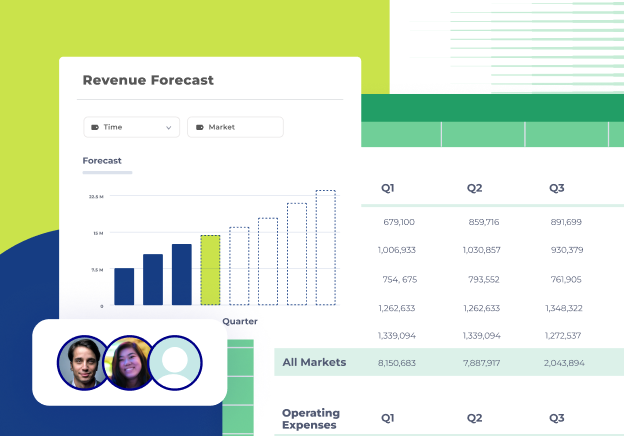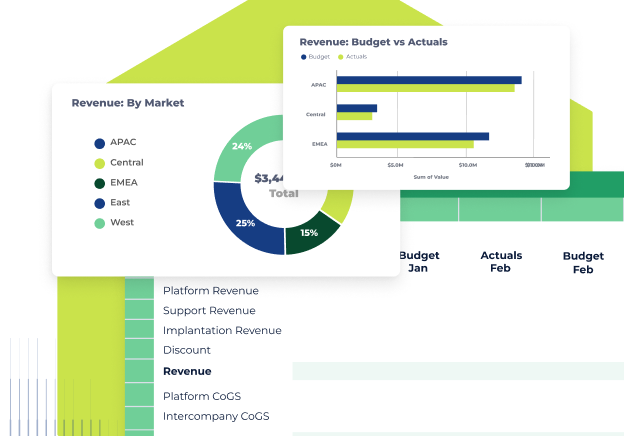Understanding AI and Machine Learning in Finance
Definition of AI in Finance
AI in finance means using technology to take on tasks like analyzing data, spotting patterns, and making decisions—things that usually require human intelligence.
For CFOs and finance teams, it’s a way to work smarter, not harder. AI helps make sense of large amounts of data quickly, so you can spot trends, improve forecasts, and make more confident decisions.
It’s about freeing up time to focus on strategy, managing risks more effectively, and finding new opportunities to drive the business forward.
Machine Learning in Finance
Machine learning, a type of AI, uses algorithms trained on large datasets to recognize patterns, make predictions, and improve over time without needing to be explicitly programmed. For CFOs and finance teams, this means having a tool that can quickly analyze complex data, identify trends, and support smarter decision-making.
For example, machine learning can help improve forecast accuracy, flag unusual transactions, or provide insights into financial performance drivers. Because these algorithms adapt as new data comes in, they’re especially valuable for staying ahead of changing business conditions and delivering more reliable, actionable insights that help finance leaders guide their organizations effectively.

Automation vs Artificial Intelligence: What's the difference?
The rise of automation changed the way CFOs and finance teams work. It gave us tools to process data faster, reduce errors, and establish a reliable source of truth. But automation has its limits—it’s great for handling repetitive tasks, but it doesn’t provide the deeper insights or forward-looking perspectives that today’s businesses need.
This is where artificial intelligence comes in. Unlike automation, AI in finance can analyze patterns, identify trends, and generate insights that help CFOs think strategically. It moves us beyond managing what has already happened and toward proactively shaping what’s next. For CFOs, this is a game-changer—it allows us to step into a more strategic role, guiding the business with data-driven confidence and agility.
AI technologies don’t replace automation; they build on it. While automation handles the heavy lifting of organizing and processing data, AI takes it further by turning that data into actionable insights. Together, they provide the foundation CFOs need to lead their teams and businesses into the future.
How is AI driving strategic finance?
Automation accelerated the CFO out of the back office. It brought precision and a source of truth. Now, in the race to become a strategic business partner, AI will empower CFOs to get there faster than with automation alone.
Automation won’t go anywhere. AI will be an AND to automation:
- [A] Where automation ends
AI steps in where automation stops. While automation organizes and processes data, AI tackles the next level—auditing large datasets, cleaning up inconsistencies, and cross-checking assumptions. This ensures the data driving your decisions is accurate and reliable, giving you a strong foundation for strategic planning.
- [N] Net-new creation
AI’s ability to generate net new outputs is one of its most transformative features. Whether it’s building financial models, creating 10-year plans, or updating forecasts based on broad assumptions, AI helps CFOs and their teams think further ahead. By taking over time-consuming tasks, it frees up the team to focus on higher-value work.
- [D] Decision support
One of AI’s greatest strengths is helping CFOs make informed decisions faster. By analyzing patterns and trends, AI delivers actionable insights and frames information in a way that’s easy to understand. This makes it easier to guide executive teams, answer big-picture questions, and communicate a clear point of view when it matters most.
These capabilities are redefining what’s possible for CFOs and finance teams. Leveraging AI in these three areas empower CFOs to spend less time buried in the details and more time driving strategy and innovation.

AI as a strategic partner to the CFO
AI is not here to replace the CFO—it’s here to support and amplify their impact.
CFOs are still the captains steering the ship. AI works alongside them, like a trusted first mate, helping them navigate complexity, uncover opportunities, and make more informed decisions.
While AI can process data at a scale and speed that humans simply can’t, it still needs direction and oversight. Just like a great team member, AI needs to be trained, managed, and aligned with business goals. Its output is only as good as the data and guidance it’s given, which makes the CFO’s leadership even more critical.
This partnership between CFOs and AI lets them focus on the strategic work that matters most—guiding the company’s vision, influencing key stakeholders, and driving business outcomes. With AI handling the heavy data lifting, CFOs can spend more time on the big-picture challenges that define success.
Practical ways CFOs are using AI to drive results
AI is changing how CFOs approach some of the most critical aspects of their role. Here are some practical ways AI is being applied in finance today:
Enhancing forecast accuracy with predictive analytics
AI can analyze historical data and real-time inputs to deliver more precise forecasts. By identifying trends and predicting potential outcomes, CFOs can make informed decisions and better prepare their organizations for what’s ahead.
Streamlining scenario planning
With AI, scenario planning becomes faster and more dynamic. CFOs can run "what-if" analyses in real time, exploring multiple paths forward and adjusting strategies based on changing conditions.
Automating variance analysis
AI simplifies variance analysis by identifying discrepancies and patterns across datasets. Instead of spending hours sifting through numbers, CFOs and their teams can quickly understand the "why" behind performance gaps and take action.
Identifying risks and opportunities in risk management
AI excels at analyzing massive amounts of data to uncover risks and opportunities, significantly enhancing risk management by identifying potential threats and optimizing decision-making processes. This enables CFOs to proactively address potential issues and seize new growth opportunities.
Improving communication with stakeholders
By distilling complex data into clear, actionable insights, AI helps CFOs present their findings in a way that resonates with boards, investors, and executive teams. This strengthens their role as a strategic partner in decision-making.

What tools exist for AI in Finance?
There are many AI tools available on the market, but it’s important to focus on solutions that address the specific needs of your business. Here’s a look at some of the top tools shaping the future of finance in 2025:
1. Cube

Cube is an FP&A software tool that streamlines financial planning, reporting, and analysis processes for businesses. With Cube's AI, finance teams never have to start from a blank spreadsheet again. Cube takes the first pass at plans and reports, so you’re free to focus on the strategy that drives the business forward.
The platform allows users to connect their existing enterprise resource planning (ERP), human resource information system (HRIS), and customer relationship management (CRM) systems directly to Excel and Google Sheets, providing a single source of truth for all financial data.
Key AI features:
- Smart forecasting: With AI Smart Forecasting, jumpstart planning tasks by creating an AI-proposed forecast that you can use as a starting point or benchmark for your existing plans.
- Proactive variance analysis: Cube's AI offers you the first analysis of your variances so you can decide where to dig in deeper to help get the company back on track.
- Automated data validation: By automatically identifying inconsistencies and highlighting potential errors, Cube helps you maintain clean, reliable data so you can drive decisions with confidence.
2. Anaplan

Anaplan is a business planning, forecasting, and performance management software platform that lets businesses connect their financial, strategic, and operational planning in real time. Recently, Anaplan has ventured into artificial intelligence and machine learning, providing practical insight into a company’s data.
Key AI features:
- PlanIQ: PlanIQ combines Anaplan’s Connected Planning platform with machine learning (ML) capabilities and deep learning algorithms to generate accurate future forecasts. It leverages Amazon’s forecast engine and Anaplan's native algorithms, such as multivariate linear regression (MVLR) and Anaplan Prophet, to help customers make more informed predictions.
- Predictive insights: Finance teams can use predictive insights to create sales plans based on customer insights and buyer-intent data. Finance teams can use it to understand their most profitable segments and target accounts.
- Optimizer: Optimizer provides predictive analytics capabilities and linear optimization algorithms.
3. Vena

Vena Insights is an FP&A platform designed to assist with financial and operational planning processes for businesses. Vena Insights provides real-time data for AI-powered reporting and financial analysis, enabling finance teams to make informed decisions.
Key AI features:
- Predictive analytics: Leverage AI to analyze historical and current data, providing insights that help you anticipate future trends and outcomes with greater accuracy.
- Predictive forecasting: Improve forecast accuracy by using advanced AI models that incorporate real-time data and adapt to changing conditions, enabling more strategic planning.
- Anomaly detection: Automatically identify outliers and unusual patterns in your data to help you address risks, inefficiencies, or potential opportunities before they escalate.
- Data Analysis Expressions (DAX): Utilize DAX formulas to create sophisticated calculations and models that add depth and precision to your analysis, making your reporting more insightful.

How CFOs can start using AI today
For CFOs, adopting AI is not just about staying competitive—it’s about transforming your finance function into a strategic powerhouse. While implementing AI might seem complex, breaking it down into clear, actionable steps can help you build momentum and achieve meaningful results. Here’s a roadmap to get started:
1. Evaluate your finance tech stack
Review the tools and systems you currently rely on. Are they equipped to handle AI-driven processes? Look for platforms that offer AI integration or built-in capabilities, like predictive analytics or machine learning models. If your tools are outdated or overly siloed, consider upgrading to a cloud-based, AI-compatible system that centralizes data and scales with your needs. Tools like Cube can bridge gaps by offering seamless AI integration with your existing workflows.
2. Focus on data quality
AI depends on accurate, clean data to generate reliable insights. Start by auditing your data sources to identify inconsistencies, gaps, or outdated information. Standardize your data formats and create processes to ensure new inputs are clean and complete. Consider implementing data governance policies to maintain quality over time. Remember: the more structured and trustworthy your data and data collection, the better AI will perform.
3. Identify high-value use cases
Pinpoint specific problems or challenges where AI can provide immediate value. For example:
- Forecasting: Use AI to analyze historical and real-time data to improve the accuracy of financial projections.
- Scenario planning: Leverage AI to run real-time “what-if” analyses for various business scenarios.
- Variance analysis: Automate the detection and explanation of performance gaps to save time and identify actionable insights.
Focus on a use case with measurable outcomes to build credibility and demonstrate ROI quickly.
4. Train your finance team
Empower your team to work effectively alongside AI tools. Provide training on understanding AI outputs, interpreting predictions, and identifying areas where AI adds the most value. For example, teach your analysts to evaluate AI-driven forecasts critically rather than taking them at face value. Create a culture where AI is seen as a collaborative tool, not a replacement for human expertise.
5. Start small and scale strategically
Begin with a pilot project that is focused and manageable. For example, implement AI or machine learning in a single process, like automating month-end reporting or improving a specific forecast. Use the results to refine your approach and build confidence in AI across your team. Once you’ve proven success, expand to more complex applications, such as company-wide scenario planning or long-term strategic modeling.
6. Set clear metrics for success
Define your goals and KPIs before implementing AI. Are you looking to reduce time spent on reporting? Improve forecast accuracy by a specific percentage? Deliver insights faster to executive leadership? Establish benchmarks to track your progress and ensure your investment in AI is delivering the results you expect.
Starting small and focusing on high-impact areas will allow you to build momentum, secure buy-in, and position your finance team as a driver of strategic growth. Remember, every step you take toward integrating AI is a step toward transforming finance into a strategic partner for the business.
AI in finance: Setting CFOs up for success
AI is reshaping the role of CFOs, turning finance leaders into strategic partners who can guide their organizations through uncertainty and change. The ability to analyze data faster, forecast more accurately, and plan proactively is no longer a luxury—it’s a necessity.
If you’re ready to take your finance team to the next level, Cube is here to help. With AI-driven tools designed to integrate seamlessly into your existing workflows, Cube empowers CFOs to save time, make smarter decisions, and achieve strategic finance goals.
Get a free Cube demo today and see how it can transform the way you lead.



.png)









.png)

.png)








.png)
![What is financial data management? [2025]](https://www.cubesoftware.com/hubfs/EBook%20Cover%20(27).png)
![Best strategic planning software for CFOs [2025 review]](https://www.cubesoftware.com/hubfs/Frame%2014-1.png)